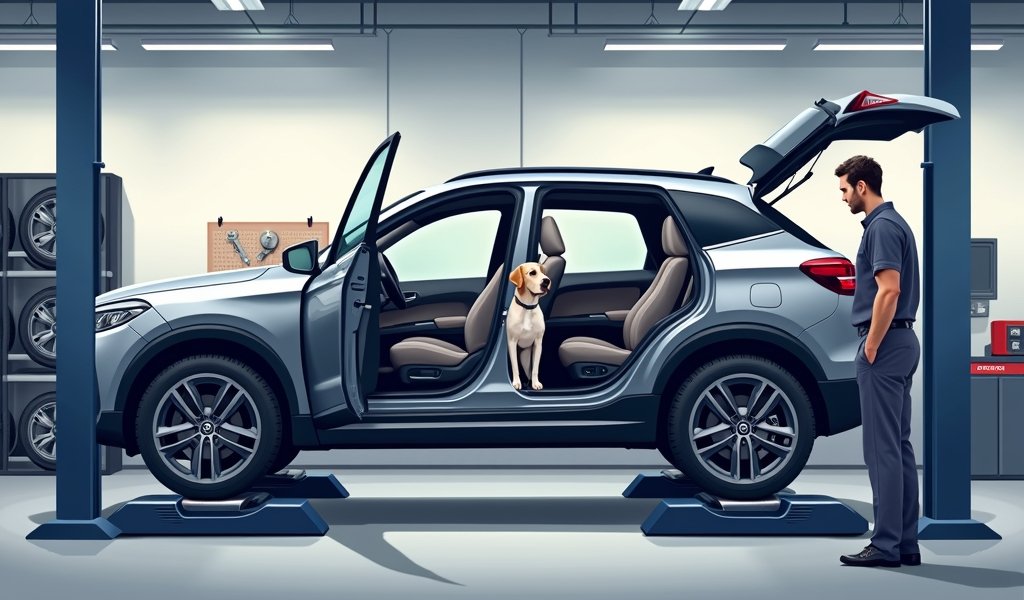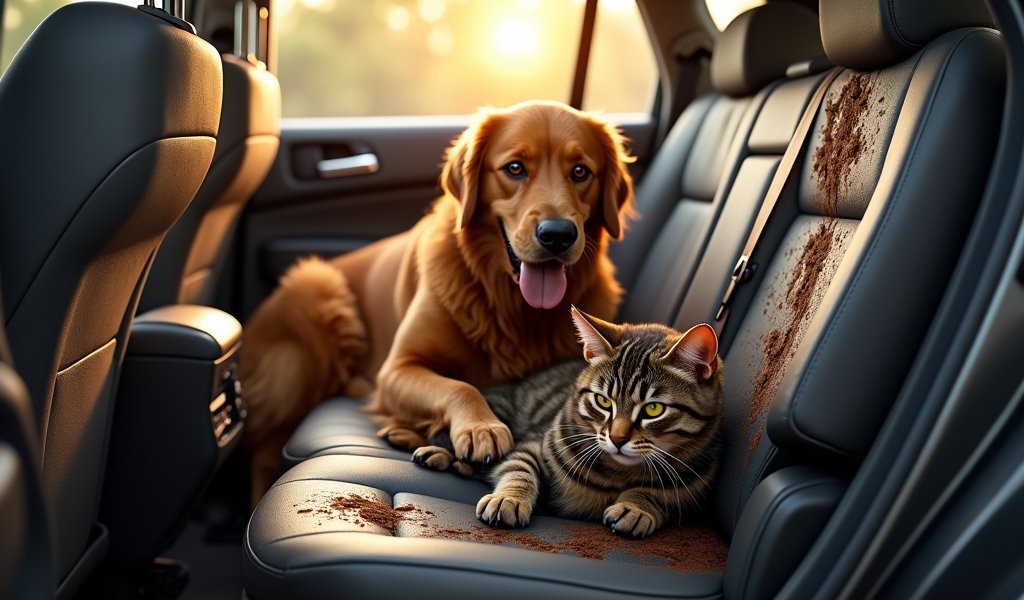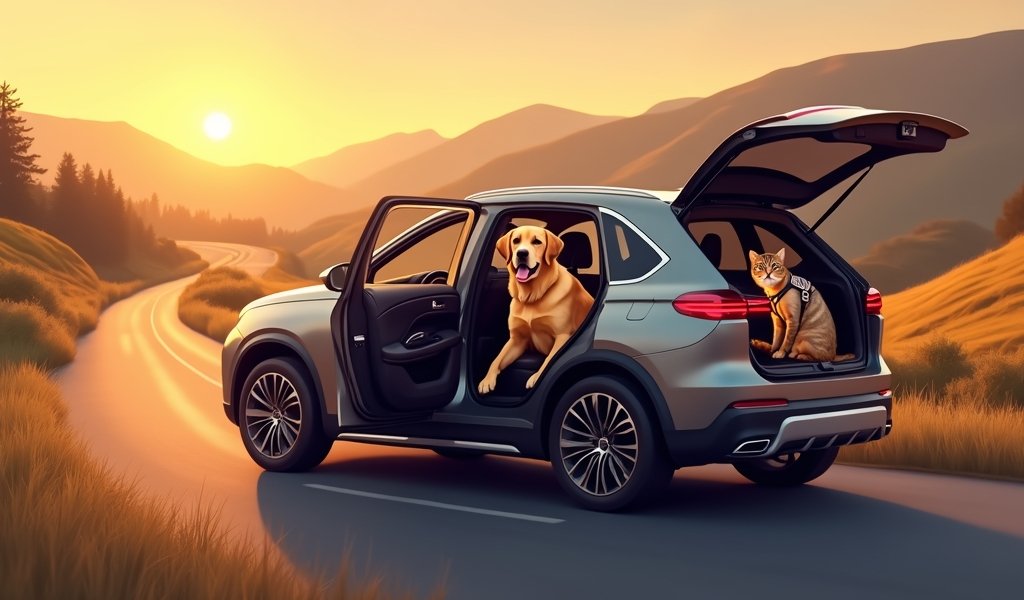Overview
This article provides five essential tips for safely traveling with pets in cars: properly securing your pet with appropriate restraints, creating a comfortable environment with temperature control and familiar items, packing necessary supplies including documentation and emergency items, maintaining routine with regular breaks, and addressing health issues like motion sickness and anxiety. The guidance emphasizes that thoughtful preparation is key to ensuring both pet and owner have a safe, low-stress journey together.
Table of Contents
- Introduction to Traveling with Pets in Car
- Safety First: Securing Your Pet for the Journey
- Comfort Matters: Creating a Pet-Friendly Car Environment
- Preparation Essentials: What to Pack for Your Pet
- Breaks and Schedule: Maintaining Routine on the Road
- Health Considerations: Preventing Motion Sickness and Anxiety
- Conclusion
- Frequently Asked Questions
Introduction to Traveling with Pets in Car
Traveling with pets in car journeys can transform an ordinary road trip into an adventure shared with your furry companion. As someone who has spent years helping pet owners navigate vehicle customizations for their four-legged friends, I’ve seen firsthand how proper preparation can make all the difference. Whether you’re planning a quick trip to the vet or embarking on a cross-country expedition, understanding how to safely transport your pet is essential for everyone’s well-being.
Many pet owners underestimate the challenges that come with having animals in vehicles. Your pet’s safety, comfort, and emotional state all require thoughtful consideration. Moreover, an unprepared pet can become a significant distraction, potentially increasing your risk of accidents. According to a study by AAA and Kurgo, 65% of dog owners admit to engaging in at least one potentially distracting activity while driving with their dog.
In this comprehensive guide, we’ll explore five professional tips for traveling with pets in car journeys, covering everything from safety equipment to comfort considerations. My goal is to help you create a travel experience that keeps both you and your pet happy, calm, and secure throughout the journey. Let’s get your vehicle pet-ready and hit the road with confidence!
Safety First: Securing Your Pet for the Journey
When traveling with pets in car settings, safety should never be compromised. Just as you wouldn’t drive without your seatbelt, your pet deserves the same level of protection. An unsecured pet can become a dangerous projectile in the event of sudden braking or a collision. Even at just 30 mph, a 10-pound dog can exert roughly 300 pounds of pressure in a crash – imagine what larger pets could do.
There are several pet safety devices designed specifically for vehicle travel. Here’s what you should consider based on your pet’s size and temperament:
- Pet safety harnesses and seatbelts that attach to your vehicle’s existing restraint systems
- Secured carriers or crates that are anchored to the vehicle
- Vehicle pet barriers that confine your pet to a specific area of your car
- Booster seats for smaller pets that allow them to see out while staying secured
The key factor is finding a solution that restricts your pet’s movement enough to keep them safe while still allowing basic comfort. For dogs, a crash-tested harness that attaches to the seatbelt offers a good balance. The Center for Pet Safety conducts rigorous testing of pet restraints, and I always recommend products that have passed their certification standards.
Remember that airbags can be dangerous for pets just as they are for small children. Keep pets secured in the back seat or cargo area whenever possible. If your vehicle has a cargo area, installing a quality car pet barrier can provide added protection while giving your larger pet more room to lie down.

Comfort Matters: Creating a Pet-Friendly Car Environment
Creating a comfortable environment is crucial when traveling with pets in car journeys, particularly for longer trips. Comfort isn’t just about luxury – it directly impacts your pet’s stress levels, behavior, and overall travel experience. A comfortable pet is typically a calmer, quieter passenger, making the journey more pleasant for everyone.
Temperature control is perhaps the most critical comfort factor. Pets, especially dogs, have limited ability to cool themselves and can quickly overheat in a warm vehicle. Even on mild days, temperatures inside a car can rise to dangerous levels within minutes. Never leave your pet alone in a parked car, even with windows cracked – it’s simply not safe.
When driving, aim to keep the interior temperature between 68-75°F (20-24°C) for optimal pet comfort. During summer travels, consider these cooling strategies:
- Use sunshades on windows where direct sunlight hits your pet
- Ensure proper airflow with strategic ventilation
- Consider cooling mats designed specifically for pets
- Keep fresh water accessible throughout the journey
Beyond temperature, create a designated pet space with familiar items from home. A favorite blanket or bed can provide both physical comfort and emotional security. The familiar scent helps reduce anxiety in an otherwise unfamiliar environment. For cats and smaller pets, line their carrier with something that smells like home.
Noise levels are another consideration that many owners overlook. While some pets enjoy music, others find it stressful. Road noise, particularly on highways, can also contribute to pet anxiety. Consider playing calming pet music designed specifically for animal stress reduction, or use white noise that blocks out road sounds. According to research published in the Journal of Veterinary Behavior, classical music has been shown to reduce stress markers in dogs.
Finally, minimize visual overstimulation for anxious pets. Some animals become stressed by watching rapidly passing scenery. If your pet seems agitated when they can see out the windows, consider partially covering their carrier or using special pet window screens that reduce visual stimuli while still allowing air flow.
Preparation Essentials: What to Pack for Your Pet
Proper preparation can make or break your experience when traveling with pets in car journeys. Just as you’d pack essentials for yourself, your furry companion needs their own travel kit. Having the right supplies readily available helps address unexpected situations and keeps routine care consistent despite changing environments.
Start with a dedicated pet travel bag containing all essentials, stored within easy reach but secure enough not to spill during travel. Here’s a comprehensive packing list for responsible pet travel:
- Food and water: Pack enough for the entire journey plus 2-3 days extra for emergencies
- Collapsible food and water bowls for convenient feeding stops
- Regular medications with a copy of prescriptions and dosing instructions
- Basic pet first aid kit including bandages, antiseptic wipes, and tweezers
- Waste management supplies: poop bags, portable litter box, litter, pet wipes
- Grooming supplies for longer trips
- Current vaccination records and health certificates (essential for crossing state or country borders)
- Recent photo of your pet (useful if they become lost)
- Familiar toys and comfort items that won’t pose choking hazards
Documentation deserves special attention when crossing jurisdictions. Different states and countries have varying requirements for pet entry. Some require specific vaccinations or health certificates issued within a certain timeframe before travel. Research your destination’s requirements well in advance and keep all documents in a waterproof container.
For longer journeys, consider investing in specialized pet car accessories that enhance comfort and convenience. Spill-proof water bowls, seat covers to protect your upholstery, and portable ramps for larger or older dogs can significantly improve the travel experience. If you’re planning frequent travel, these items quickly become worthwhile investments.
Perhaps the most overlooked preparation element is identification. Ensure your pet wears a collar with current contact information at all times. For added security, consider temporary travel tags with your destination address and phone number. Microchipping provides a permanent form of identification and is highly recommended before any significant travel.
Finally, research pet-friendly accommodations and veterinary clinics along your route before departing. Having this information readily available provides peace of mind should you need to make an unexpected stop or encounter a medical emergency.
Breaks and Schedule: Maintaining Routine on the Road
When traveling with pets in car settings, maintaining a consistent schedule helps reduce stress and prevents accidents or behavioral issues. Pets thrive on routine, and while travel inevitably disrupts their normal patterns, strategic breaks and schedule adherence can make a significant difference in their adjustment to life on the road.
Plan for regular breaks every 2-3 hours, regardless of how well your pet seems to be handling the journey. These stops serve multiple purposes:
- Bathroom opportunities to prevent accidents in the vehicle
- Brief exercise to help burn energy and reduce restlessness
- Mental stimulation through new smells and environmental exploration
- Hydration breaks with fresh water offerings
- Opportunity to check your pet for any signs of distress or discomfort
When planning your route, research pet-friendly rest areas or parks along the way. Many highway rest stops now include designated pet areas, but quality varies significantly. Apps like BringFido can help identify suitable stopping points that allow pets to stretch their legs safely away from highway traffic.
Safety during breaks requires special attention. Never allow your pet off-leash in unfamiliar or unsecured areas, regardless of how well-trained they typically are. The combination of new environments and travel stress can make even the most obedient pets unpredictable. Use a secure harness rather than just a collar when walking dogs near traffic areas, as a startled pet might slip out of a collar.
Feeding routines require thoughtful adjustment during travel. For most pets, maintaining their regular feeding times helps provide stability, but consider these modifications:
- Feed slightly smaller portions than usual to reduce the risk of motion sickness
- Schedule meals during longer stops rather than while the vehicle is moving
- Allow 1-2 hours for digestion before resuming travel after a meal
- Keep treats handy for positive reinforcement during the journey
For overnight trips, try to recreate bedtime routines as closely as possible. If your pet normally sleeps in a crate at home, having a travel crate with familiar bedding can provide security in strange environments. Maintain consistent bedtimes and wake-up times when possible, as sleep disruption can contribute significantly to travel stress.
Remember that pets often sense our emotions. If you’re stressed about the journey, they’re more likely to feel anxious too. Build extra time into your travel schedule to accommodate unhurried breaks and unexpected delays. The more relaxed you remain about maintaining the schedule, the more likely your pet will adapt comfortably to the journey.

Health Considerations: Preventing Motion Sickness and Anxiety
Health issues can quickly turn a pleasant journey into a stressful experience when traveling with pets in car environments. Two of the most common challenges – motion sickness and travel anxiety – often go hand-in-hand and require proactive management. Understanding how to prevent and address these conditions will significantly improve your travel experience.
Motion sickness in pets presents similarly to humans, with symptoms including:
- Excessive drooling or salivation
- Frequent swallowing or licking lips
- Restlessness or inability to get comfortable
- Whining or vocalization
- Vomiting or retching
- Lethargy or unusual stillness
Prevention strategies for motion sickness begin with proper positioning. Center-facing seats or positions where your pet can see out the front windshield often reduce symptoms, as this helps their brain reconcile the visual motion with what their body feels. For smaller pets, specially designed booster seats can help achieve this optimal viewing angle.
Managing feeding before travel plays a crucial role in preventing sickness. Feed your pet a light meal 3-4 hours before departure, avoiding heavy or rich foods. Keep fresh air circulating in the vehicle, as stuffy conditions can exacerbate nausea. For pets with persistent motion sickness, consult your veterinarian about appropriate medications – several safe and effective options exist specifically formulated for animal travel.
Travel anxiety represents a separate but related challenge. Signs your pet may be experiencing anxiety include:
- Excessive panting not related to heat
- Trembling or shaking
- Attempting to hide or escape
- Unusual aggression or defensive behavior
- Excessive vocalization
- Inappropriate elimination
For anxiety management, gradual desensitization proves most effective as a long-term solution. Before your major journey, take your pet on progressively longer car rides with positive reinforcement. Begin with simply sitting in the stationary vehicle with treats and praise, then advance to short trips around the block, gradually increasing duration.
During travel, anxiety-reducing products can provide additional support. Calming pheromone sprays like Adaptil for dogs or Feliway for cats mimic natural calming signals. Compression garments such as Thundershirts apply gentle, constant pressure that many pets find soothing. For severe cases, your veterinarian might recommend appropriate anti-anxiety medications for specific travel situations.
Regardless of your management approach, monitor your pet closely throughout the journey. What works for one animal may not work for another, and strategies often need adjustment based on your pet’s specific responses. Pay attention to subtle behavioral changes that might indicate developing discomfort before it escalates to serious distress.
Conclusion
Traveling with pets in car journeys doesn’t have to be stressful when you apply these professional tips. By prioritizing safety through proper restraints and carriers, creating a comfortable environment, packing essential supplies, maintaining consistent routines with strategic breaks, and addressing health considerations proactively, you’ll set the foundation for successful travels with your furry companion.
Remember that each pet is unique – what works perfectly for one may need adjustment for another. Pay attention to your pet’s specific signals and be willing to modify your approach accordingly. The key is patience and preparation, allowing both you and your pet to enjoy the journey rather than just enduring it.
With thoughtful planning and the right equipment, your vehicle can become a safe, comfortable extension of home for your pet. Whether you’re embarking on weekend adventures or cross-country relocations, these strategies will help ensure that traveling with pets in car settings becomes a positive experience for everyone involved. Safe travels!
Frequently Asked Questions
How long can pets safely travel in a car?
Most pets can travel 6-8 hours per day with proper breaks every 2-3 hours. Extend travel time gradually with experience, always monitoring your pet for signs of distress.
Should I feed my pet before a car trip?
Feed your pet a light meal 3-4 hours before departure to prevent motion sickness. Avoid feeding immediately before or during travel unless on extended journeys.
What’s the safest place for my dog in the car?
The back seat with a proper harness attached to the seat belt or a secured crate is safest. Never allow pets in the front seat where airbags could cause injury.
How can I calm my anxious pet during car travel?
Use familiar bedding, calming pheromones, compression garments, and gradually acclimate them with short trips. For severe anxiety, consult your veterinarian about appropriate medications.
Are there laws about traveling with pets in cars?
Many states have distracted driving laws that apply to unrestrained pets, and some explicitly require pet restraints. Always check local regulations for your route and destination.


Pingback: Best Cars for Dog Owners: Ultimate Care - knowsyourcar.com